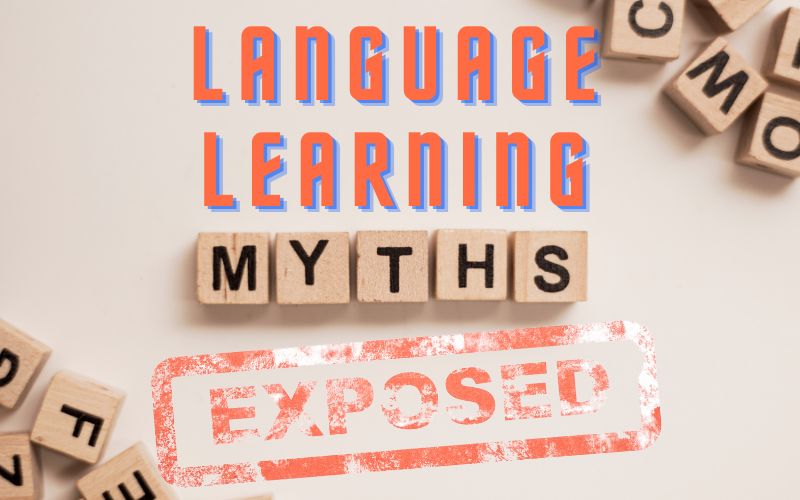Myth-conceptions About Children Learning a Second Language
By David Shaffer
Myths die hard. Myths in general are misconceptions held by a culture or society, large or small, and persist in almost any area of endeavor that one can think of. They are very difficult to dislodge even if they can be proven to be false. So it is with the field of second language learning. Here we will present several of the many myths related to children learning a second language as well as the truth that debunks them.
MYTH 1: Children Are Better Language Learners
We have all seen how children learn their first language (L1): without taking classes, without a tutor, without a coursebook, an expensive app, or a dictionary. There is the critical period hypothesis, which states that the first few years of life are critical to acquiring a language; if one is not presented with L1 input until after this critical period, they will never become fluent. This hypothesis is for one’s L1; things are not the same for learning a second language (L2).
When learning an L2, the child already has their L1 language system in place, just as an adult learner does, which interferes with L2 learning. Also, a child’s cognitive abilities are not yet fully developed, whereas those of an adult are, putting a child at a disadvantage in this respect. However, children are not constrained by the worry of making errors that is so common among adults. The effort that children put into learning an L2 is not much different than that of adults. Children are not really better L2 language learners; they just go about it in a different way. There is one area in which children do, however, seem to excel in L2 language learning: the ability to acquire native-like L2 pronunciation.
MYTH 2: Children Are Like Sponges for Any Language
While this may be true for anyone learning their L1, when learning an L2, children already have an L1 in place just as an adult does, and this L1 may interfere to a greater or lesser degree in learning an L2. The ease of learning an L2 depends a lot on the degree of similarity of the L2 to the L1. For example, the Romance languages (Spanish, Italian, Portuguese, French, etc.) are considered to be the easiest languages for an L1 English speaker, child or adult, to learn because of their lexical, grammatical, pronunciation, and writing system similarities with English. In contrast, Arabic, Mandarin Chinese, Japanese, and yes, Korean are considered to be the four most difficult languages for an English speaker, young or older, to learn due to the differences in their writing and phonetic systems as well as in their lexis and syntax. The same holds true for Korean L1 speakers: English is among the most difficult languages for them to learn.
There are additional factors that play a role in determining the ease and speed with which an L2 is learned, both for children and adults. How much exposure they have to the language is one factor. The type of exposure is another: Is the exposure via TV or the internet, or is it face-to-face interaction? A third factor is how relevant the input is to their daily lives. So, “for any language” is the most untrue part of this myth: Some children and some adults may act like sponges for some L2 languages, but for other L2 languages, those sponges are much less absorbent.
MYTH 3: You Need to Have a “Language Gene” to Be a Good Language Learner
The truth is that there is no “language gene.” Even Chomsky’s proposed LAD (language acquisition device) as an innate biological module of the brain has been losing support over the five decades since it was first proposed. Learning a language, L1 or L2, is more of a skill than an innate gift. Take basketball for example: Though some individuals may have more inborn talent than others, it takes much practice and dedication to acquire the skills needed to be a proficient basketball player.
Yes, there is a gene called FOXP2, which is believed to play a role in language acquisition. The gene, however, has a much more general role than merely language learning: This gene is thought to be responsible for transforming new experiences into routine procedures, and language learning is merely one of the gazillion new experiences that a person may have. The gene is believed to be responsible for developing motor memory – whether that motor memory is in L2 learning, bicycle riding, or swishing a basket from half-court Steph Curry style. Practice and dedication are the main factors in learning each of these skills.

MYTH 4: The Earlier, the Better for a Child to Begin L2 Learning
Granted that there are some advantages to learning an L2 early in life (good L2 pronunciation, feeling comfortable with the foreign language), the disadvantages outweigh the advantages. Remember that children’s brains are still developing: The younger the child, the lower the cognitive development. In other words, younger children are less able to analyze linguistic input. What might take a ten-year-old 10 hours to learn, might take, for example, 25 hours for a five-year-old to master. When thinking of the costs involved in instructed language learning, this efficiency factor becomes quite important – for parents deciding on private tutoring for their young one as well as for public school policy-makers. Because older children are more developed cognitively, it would not take too long for the ten-year-old beginner to reach the L2 proficiency level of that five-year-old who had started their L2 learning five years earlier. So, the earlier a child begins to learn an L2, the less efficient they are at the beginning of their language learning and the more expensive their language learning is in terms of amount of uptake occurring.
MYTH 5: Learning an L2 When Young Interferes with L1 Learning
This was an argument that was voiced by those opposed to instituting English as a subject in Korean elementary schools back around 1997 when the government did decide to begin English teaching in Grade 3. The argument went that because children were still learning their first language, Korean, learning English would hinder their L1 learning. However, in reality, this would not be the case. For one thing, the input of the two languages was to be greatly imbalanced: 3rd- and 4th-graders were to get two hours of English instruction per week, while the rest of the week, the children would be in a Korean speaking environment. Even if a child were beginning to learn both Korean and English at the same time, with this input imbalance, their Korean learning would far surpass their English learning, and it would thus be their Korean that would be interfering with their English learning! This was just a hypothetical example. In actuality, by the age of about four or so, children have already developed the basic framework of their L1 language system (learning additional vocabulary, expressions, and advanced structures, of course, continues through adulthood). So, when a child begins learning English at age 8 in elementary school (or even younger), they already possess a highly developed L1 system, which a couple of hours of English input per week will not interfere with.
MYTH 6: Learning Two Languages at Once Is Too Difficult
This misconception is related to the one above. It differs, however, in that it assumes that for the two languages being learned, the onset of learning begins around the same time and the amounts of input are more or less equal. What is important to consider here is the number of synapses that a young child’s brain contains in addition to its neuroplasticity. The brain of a three-year-old is thought to have somewhere around 1,000 trillion synapses (no, that is not a typo); this is so many more than any brain uses that by the time the child reaches adulthood, the number of synapses has been reduced by about one half through synaptic pruning (but still so much more than any human needs). This information is presented to illustrate that the child’s brain has far, far more capacity than that needed to learn two, or even more, languages at the same time.
Let’s consider multilingual countries and the languages that children in these countries learn. India, for example, is said to have almost 20,000 languages and dialects (no typo here either). It is quite common for children in India to naturally learn multiple languages before ever going to school to receive instructed learning. The specific languages and the number are dependent upon which languages are spoken in the child’s linguistic environment. The same is true of Nigeria with its 500-plus languages. Ditto for South Africa with its 11 official languages and for Switzerland with its 4 official languages. Learning two or more languages at once does not markedly slow the rate of language learning, nor does it appear to be difficult. This language learning is occurring naturally; if it were sensed to be difficult, the learning would not occur. So, learning two languages, or more, at the same time is not too difficult – especially for children with their super-wired brains.
We hope that the explanations set down here help to dispel these six common myths about children and language learning that have continued to persist in what we consider to be a world based on scientific principles.




